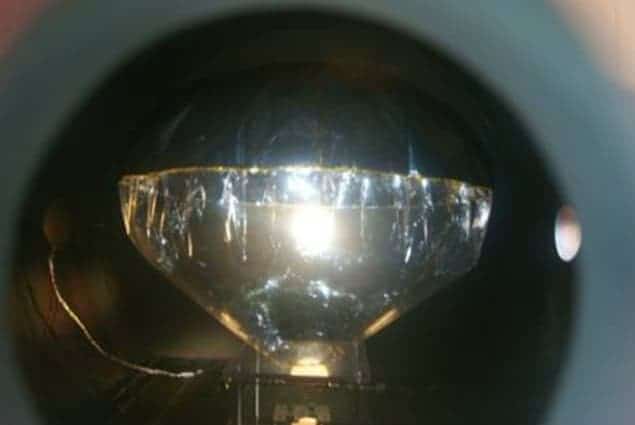
A new type of inflatable antenna has been designed for CubeSats – the miniaturized spacecraft that have reduced the cost of putting scientific equipment into Earth orbit. The antenna was created by researchers in the US, who believe that their invention could lead to CubeSats being used for interplanetary missions.
CubeSats are roughly the size of a shoebox and have masses between 1.4–4 kg. Given their small size, they can often piggyback on the launches of larger space missions. As a result, the cost of getting a CubeSat into space is a fraction of that for traditional satellites and opens the door to wider participation in space-based research.
However, there are currently some significant limitations with CubeSats, including limited communication capabilities with ground stations. This problem arises because large, far-ranging satellite dishes cannot be fitted to these tiny craft. Instead, CubeSats have so far been equipped with smaller, less-powerful systems with limited range. This is one of the reasons why CubeSat missions to date have been restricted to low orbits: 300–1000 km above the surface of the Earth.
Sublimating powder
The idea proposed in this new research is to fit CubeSats with a small balloon-like device that expands into a larger antenna once the craft is in space. The device is constructed from a 50.8-μm-thick film made from Mylar, which can be folded into a 10 cm3 volume within the CubeSat before launch. Once in space, the reduced pressure causes a small amount of benzoic-acid powder that is stored within the device to sublimate, which releases gas that inflates the device into an antenna with a width of 1 m.
The group behind the inflatable design is led by Alessandra Babuscia, who is currently based at NASA’s Jet Propulsion Laboratory (JPL) in California and who launched the project while working at the Massachusetts Institute of Technology (MIT). Babuscia told physicsworld.com that the project was inspired by an informal conversation that she had with a colleague about the idea of sending a CubeSat to an asteroid. “There are lots of talks these days at conferences about the possibility of making CubeSats interplanetary,” she says.

If this research does lead to a viable technology, it would not be the first time that an inflatable antenna has been used for space missions. However, the specific challenge this time was to devise a mechanism for inflating the antenna that did not rely on the bulky systems of pressure valves used in previous versions. The sublimation route employed by Babuscia and her group was inspired in part by NASA’s Project Echo in the late 1950s, which used a sublimation process for two balloon satellites that were launched in the 1960s.
To see whether the antenna does indeed inflate to the predicted form, the group tested the device in a vacuum chamber at MIT, where the researchers lowered the pressure to just above that experienced in space. They also did computer simulations showing that a cylindrical version of the device performed slightly better than a conical one. The simulations show that the device transmits data 10 times faster – and seven times farther – than existing CubeSat antennas. Babuscia says that at this performance, a CubeSat could communicate with Earth from at least the distance of the Moon.
Threat of micrometeorites
The research also explored some of the challenges with using the antenna as part of a CubeSat mission, which includes addressing the threat of micrometeorites. By including a slight excess of sublimating powder, the antenna can continue to re-inflate itself in the event of small punctures caused by collisions with space debris. The researchers use meteorite flux data from the Space Environment Information System (SPENVIS) to estimate that even with small leaks, the antennas can remain inflated for several years.
The next stage of the research is to run further tests, including a more detailed examination of the electromagnetic properties of the antenna by testing it in an anechoic chamber. “We need to repeat and do more tests, especially to test the reaction of the system to collisions with bigger particles,” says Babuscia. The radiation characteristics of the antenna have been tested but results will be not be revealed until an upcoming paper to be presented at IEEE Aerospace Conference in March 2014.
The inflatable-antenna concept proposed in this research has caught the interest of Pierpaolo Pergola, an aerospace engineer from the University of Pisa in Italy. “I think that the concept is definitely robust and interesting but more complete-system analyses are required before having an off-the-shelf CubeSat subsystem,” he says. In August, Pergalo published a paper detailing a proposed mission to the near-Earth asteroid Cruithne, which involved the use of CubeSats. Pergalo believes that one of the potential hazards that needs to be investigated further is the increased atmospheric drag in low Earth orbit, which could affect the trajectory of the craft.
The antennas are described in the proceedings Aerospace Conference, 2013 IEEE.



